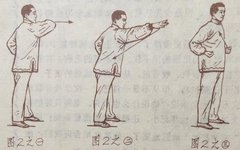“Hunyuan Yiqigong” is a practice that originated from the Nanjing National Martial Arts Institute during the Republic of China period. It can be regarded as the treasure of the National Martial Arts Institute.
“Hunyuan Yiqigong” involves simple and natural breathing techniques, where one does not hold their breath or exert force during practice. The movements are straightforward, easy to learn, and cover all areas of the body, progressing from light to heavy and from few to many, adhering strictly to the prescribed methods. By practicing twice daily, morning and evening, over time, one can dispel illness and enhance physical fitness, strengthening muscles and bones. This practice requires only a small space and can be performed indoors or outdoors, with the complete set of movements taking no more than 15 minutes. After practicing, the qi and blood flow freely, leaving one feeling comfortable throughout the body.
This qigong, like other forms, is guided by intention, using consciousness to direct the flow of qi. It also combines stillness and movement, functioning as a breathing exercise.
Breathing Movements
The breathing movements must be practiced simultaneously by two people, with identical movements. Below, only one person’s breathing movements will be described. After completing the breathing movements, practice the striking movements.
Preparation Position:
Action: Stand with feet shoulder-width apart, toes pointing forward; both hands clenched into fists, elbows bent and held at the sides of the waist, palms facing upward; gaze straight ahead (as shown in Figure 1 and Figure 2, position three).
Key Points: Stand relaxed, with a calm mind, shoulders relaxed, neck straight, tailbone aligned, and toes gripping the ground.
(1) Zhou Tian Man Yun (Circulating Qi Around the Body)
1. Right Push Palm Breathing
Action: Bend the right fist and place the elbow in front of the right chest, keeping the elbow level with the shoulder, palm facing down; slightly twist the upper body to the left, gazing at the elbow tip; the left fist and both feet remain still (as shown in Figure 2, position one).
Continuously, the right fist transforms into a palm, palm facing down, edge facing forward. With a deep exhale, extend the shoulder and arm forward slowly; at the peak of the movement, straighten the wrist, turning the palm to face forward; the palm’s tiger mouth should be rounded, and at the same time, exhale completely, focusing the intention on the fingertips while keeping the left fist and both feet still (as shown in Figure 2, position two).
Continuously, as the right palm, with a deep inhale, slowly forms a fist and returns to the right side of the waist, palm facing upward; at the same time, inhale completely, followed by swallowing saliva (as if swallowing water), gaze straight ahead: do not exhale until the left push palm breathing is performed (as shown in Figure 2, position three).
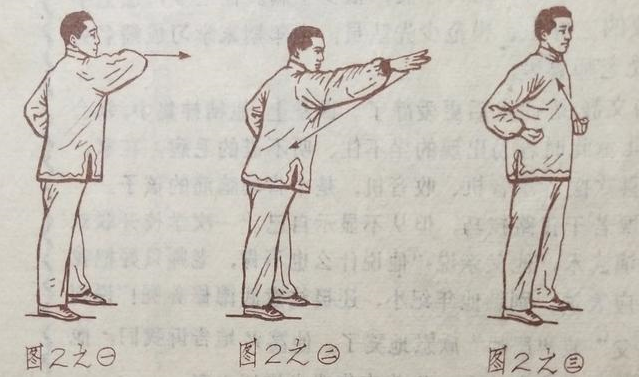
Key Points: Tongue against the upper palate, push palm and retract fist, one exhale and one inhale, exhale through the mouth and inhale through the nose, shoulders relaxed, chest wide, and abdomen firm. The push palm should have pushing force, and the retracted fist should have pulling force.
2. Left Push Palm Breathing
The action key points are the same as for the right push palm breathing, only the left palm is used (as shown in Figure 3, positions one, two, and three).
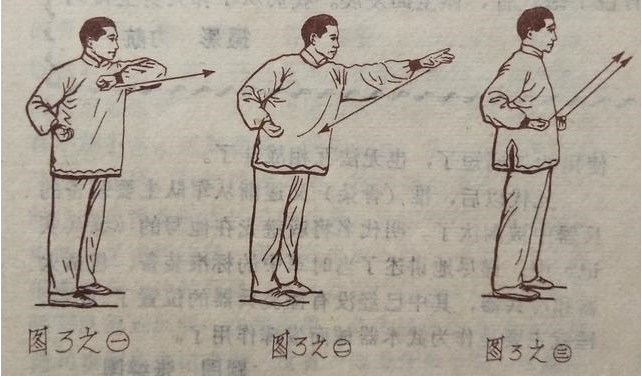
3. Double Insert Palm Breathing
Action: Both fists transform into palms, palms facing upward, fingertips pointing forward, tiger mouths rounded; with a deep exhale, extend the shoulders and arms forward slowly, reaching the front peak, exhaling completely, palms level with shoulders, gaze at the fingertips; focus the intention on the fingertips (as shown in Figure 4, position one).
Continuously, with palms facing down, as you deeply inhale, slowly form fists and return to the sides of the waist, palms facing upward; at the same time, inhale completely, followed by swallowing saliva, and after swallowing, you can exhale; focus on the dantian, gaze straight ahead (as shown in Figure 4, position two).
Key Points: Tongue against the upper palate, insert palms and retract fists, one exhale and one inhale, exhale through the mouth and inhale through the nose. “Focus on the dantian to absorb clear qi, elevating clear and descending turbid qi to nourish the body.” Shoulders relaxed, chest wide, and abdomen firm. The insert palms should have upward force, and the retracted fists should have pulling force.
(2) Zhuang Gong Yun Qi (Stance Work Breathing)
1. Embracing the Moon in the Chest
Action: Continuing from the previous movement. Both fists transform into palms, palms facing upward, with palms facing each other in front of the abdomen; as you deeply inhale, bend the arms and slowly lift them under the chin, keeping the elbows level with the shoulders, while inhaling completely, do not exhale until pressing down the palms, both legs remain still; gaze straight ahead (as shown in Figure 5, position one).
Continuously, as you exhale, rotate the palms inward to face down, with the edges facing forward, palms facing each other; as you exhale, press down forcefully on the lower abdomen, while simultaneously jumping to the sides, landing in a half-squat horse stance, knees outward, and knees vertical without exceeding the toes; gaze straight ahead (as shown in Figure 5, position two).

Continuously, as you deeply inhale, rotate the palms outward, forming fists and returning to the sides of the waist, palms facing upward; at the same time, inhale completely, followed by swallowing saliva, do not exhale until the “Great Roc Spreads Its Wings” position, gaze straight ahead (as shown in Figure 5, position three).
Key Points: Relax shoulders, lift palms while inhaling, press down with straight arms, jump and land in a horse stance, using qi to drive force together.
2. Great Roc Spreads Its Wings
Action: As you deeply exhale, both fists transform into palms, rotating inward to face down, edges facing left and right, extend the shoulders and arms, slowly spreading to the sides; when reaching the left and right peaks, straighten the wrists, turning both palms to face left and right, palms level with shoulders; at the same time, exhale completely, focusing the intention on the fingertips; gaze straight ahead, horse stance remains still (as shown in Figure 6, position one).
Continuously, as you deeply inhale, both palms slowly form fists, bending the arms and returning to the sides of the waist, palms facing upward; at the same time, inhale completely, followed by swallowing saliva, after swallowing, you can exhale, horse stance remains still; gaze straight ahead (as shown in Figure 6, position two).

Key Points: Extend shoulders and arms, using qi to penetrate the limbs, neck straight and level, do not shake the hips. Spreading wings should have upward force, and retracting fists should have pulling force.
(3) Left Bow Step Breathing
1. Right Qinglong Probes Claw
Action: Continuing from the previous movement, turn the body to the left, bending the left knee into a bow stance, with the left toes pointing forward, the right leg straightened, toes turned inward at 45°, heel firmly on the ground; the right fist bends and places the elbow in front of the right chest, elbow level with the shoulder, palm facing down, slightly twisting the upper body to the left; gaze at the elbow tip (as shown in Figure 7, position one).
Continuously, the right fist transforms into a palm, palm facing down, edge facing forward; as you deeply exhale, extend the shoulder and arm forward slowly, reaching the front peak, straightening the wrist, palm facing forward, tiger mouth rounded; at the same time, exhale completely, focusing the intention on the fingertips; gaze at the fingertips (as shown in Figure 7, position two).
Continuously, as the right palm, with a deep inhale, slowly forms a fist and returns to the right side of the waist, palm facing upward; at the same time, inhale completely, followed by swallowing saliva; gaze straight ahead; do not exhale until the left probe claw is performed (as shown in Figure 7, position three). Key Points: Tongue against the upper palate, shoulders relaxed, probe claw and retract fist, one exhale and one inhale; do not lean forward or backward, and be cautious of arching the hips.
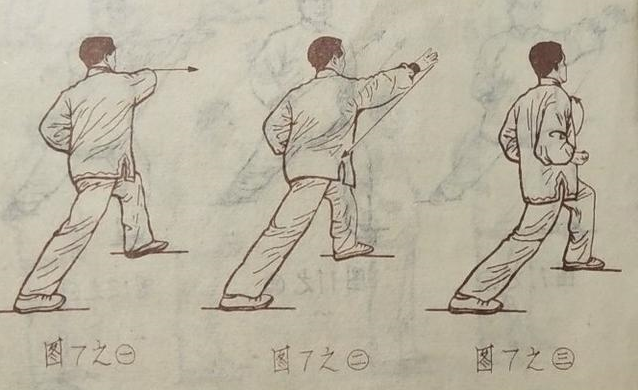
2. Left Qinglong Probes Claw
The action key points are the same as for the right Qinglong probes claw, only the left hand is used (as shown in Figure 8, positions one, two, and three).
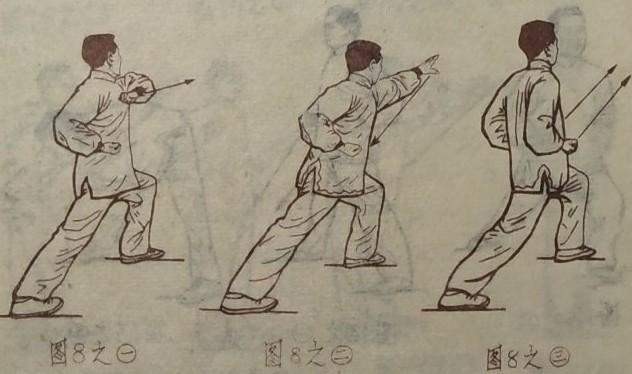
3. Double Probes Claw
Action: Both fists transform into palms, palms facing upward, fingertips pointing forward, tiger mouths rounded; as you deeply exhale, extend the shoulders and arms forward slowly, reaching the front peak, when reaching the front peak, both arms rotate inward, palms facing down; exhale completely, palms level with shoulders; gaze at the fingertips, focusing the intention on the fingertips, left bow stance remains still (as shown in Figure 9, position one).
Continuously, with palms facing down, as you deeply inhale, both palms slowly form fists and return to the sides of the waist, palms facing upward; at the same time, inhale completely, followed by swallowing saliva, after swallowing, you can exhale, focus on the dantian; gaze straight ahead (as shown in Figure 9, position two).
Key Points: Tongue against the upper palate. Probe claw and retract fist, one exhale and one inhale, exhale through the mouth and inhale through the nose, “Swallowing saliva” (as if swallowing water), shoulders relaxed, chest wide, and abdomen firm, pressing the hips and locking the groin, be cautious of arching the hips. The forward probing claw should have upward force, and the retracted fist should have pulling force.
(4) Right Bow Step Breathing
The action key points are the same as for the left bow step breathing, only the direction is reversed (as shown in Figures 10, 11, and 12).
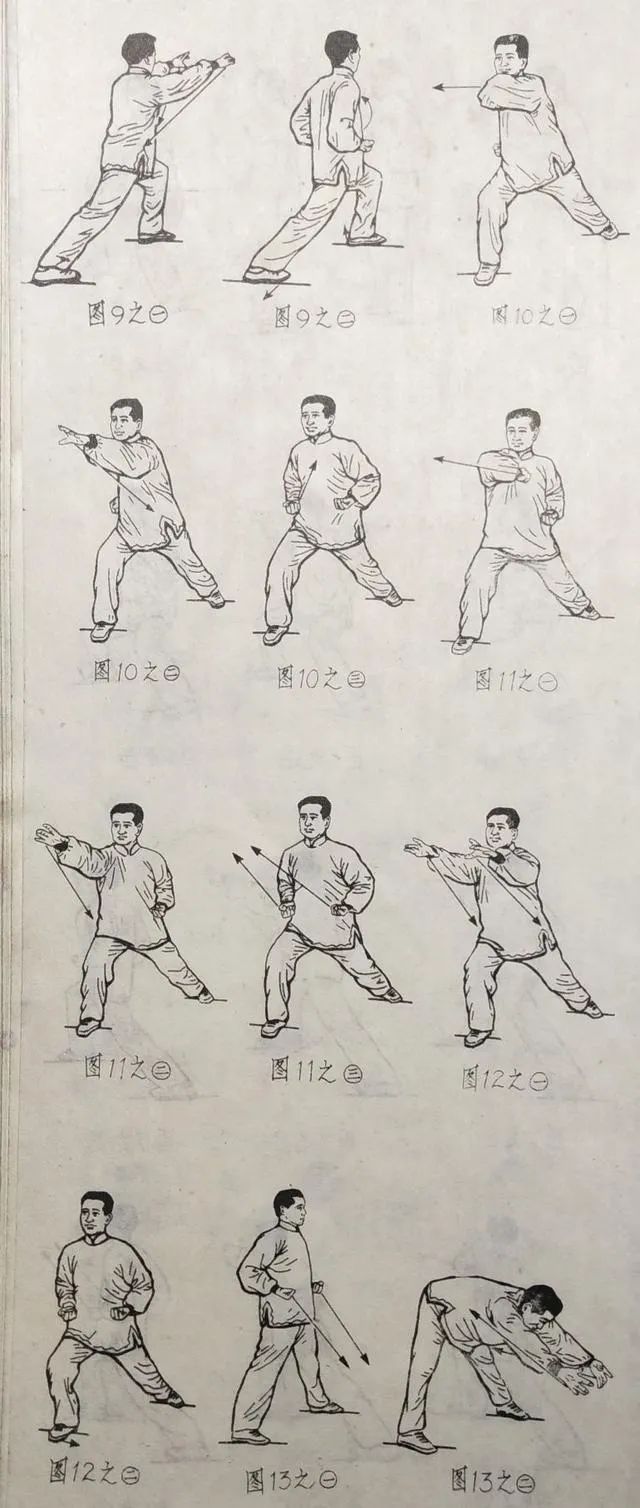
(5) Bent Body Qi Adjustment
1. Fishing for the Moon at the Bottom of the Sea
Action: Continuing from the action in Figure 12, turn the body to the left, toes pointing forward, both legs straightened (as shown in Figure 13, position one). Continuously, bend the upper body forward 90°; keep the neck straight and level, back straight and waist relaxed; while bending the upper body forward, both fists transform into palms, palms facing inward, as you deeply exhale, both palms move in an arc to the sides, slowly extending forward to the front of the head, palms facing each other; at the same time, exhale completely, gaze at the ground (as shown in Figure 13, position two).
Continuously, as both palms, with a deep inhale, slowly return to the sides of the waist and transform back into fists, palms facing upward; as both palms return, the upper body slowly rises; at the same time, inhale completely, followed by swallowing saliva; gaze straight ahead; do not exhale until the “Holding Up the Sky with Double Pillars” position, then exhale (as shown in Figure 13, position three).
Key Points: When bending the upper body forward and extending the palms, try to relax the shoulders and pull the back, using strength to embrace as if holding a round stone.
2. Holding Up the Sky with Double Pillars
Action: Both fists transform into palms, palms facing inward, as you deeply exhale, slowly extend the shoulders and arms upward; when reaching the peak, exhale completely, arms close to the ears, focusing the intention on the fingertips, both legs remain still (as shown in Figure 14, position one).
Continuously, both palms rotate inward and bend forward, while both heels lift up to inhale (as shown in Figure 14, position two).
Continuously, heels return to the ground, exhale, and keep the hands still; this action is repeated three times (as shown in Figure 14, position three).
Continuously, as you deeply inhale, both palms slowly lower to the sides of the waist, transforming back into fists, palms facing upward; at the same time, inhale completely, followed by swallowing saliva, then exhale, focusing on the dantian; gaze straight ahead (as shown in Figure 14, position four).
Key Points: When raising the palms, there should be upward force, and when lowering the palms, there should be pulling force, neck straight and level, shoulders relaxed, chest wide, and abdomen firm, focusing on the dantian.
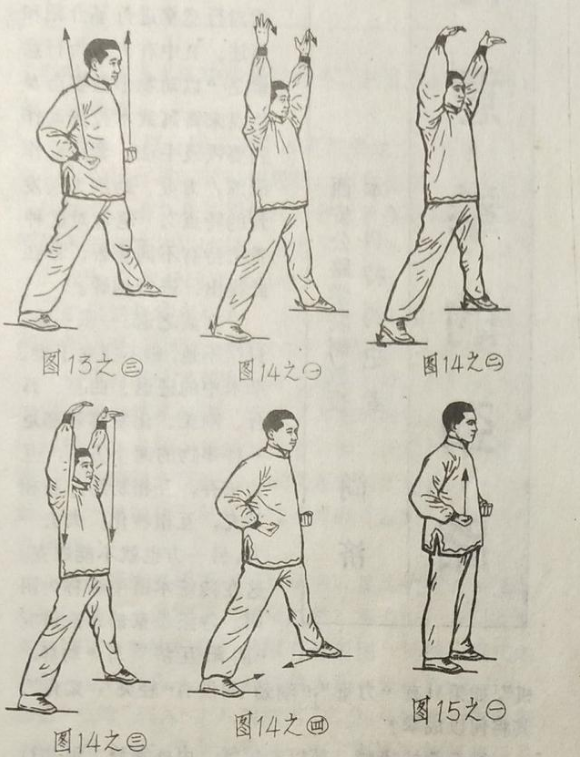
(6) Restoring and Concluding Movements
1. Right Push Palm Breathing
Action: Continuing from the previous movement, pivoting on the heels, toes turned inward; then pivoting on the balls of the feet, heels turned inward. This action is repeated three times, bringing the feet together to stand formally, with both fists remaining still; gaze straight ahead (as shown in Figure 15, position one).
Continuously, the right fist bends and places the elbow in front of the right chest, elbow level with the shoulder, palm facing down, slightly twisting the upper body to the left, while the left fist and both feet remain still; gaze at the elbow tip (as shown in Figure 15, position two).
Continuously, the right fist transforms into a palm, palm facing down, edge facing forward; as you deeply exhale, extend the shoulder and arm forward slowly, reaching the front peak, straightening the wrist, palm facing forward, tiger mouth rounded; at the same time, exhale completely, focusing the intention on the fingertips, while the left fist and both feet remain still (as shown in Figure 15, position three).
Continuously, as the right palm, with a deep inhale, slowly forms a fist and returns to the right side of the waist, palm facing upward; at the same time, inhale completely, followed by swallowing saliva (do not exhale until the left push palm is performed); gaze straight ahead (as shown in Figure 15, position four).
Key Points: Same as the key points for the right push palm breathing in Figure 2.
2. Left Push Palm Breathing
The action key points are the same as for the right push palm breathing, only the left palm is used (as shown in Figure 16, positions one, two, and three).
3. Double Insert Palm Breathing
Action: Both fists transform into palms, palms facing upward, fingertips pointing forward, tiger mouths rounded; as you deeply exhale, extend the shoulders and arms forward slowly; when reaching the front peak, both arms rotate inward, palms facing down; exhale completely, palms level with shoulders; gaze at the fingertips, focusing the intention on the fingertips (as shown in Figure 17, position one).
Continuously, as you deeply inhale, both palms slowly form fists and return to the sides of the waist, palms facing upward; at the same time, inhale completely, followed by swallowing saliva, then exhale; focus on the dantian, gaze straight ahead (as shown in Figure 17, position two).
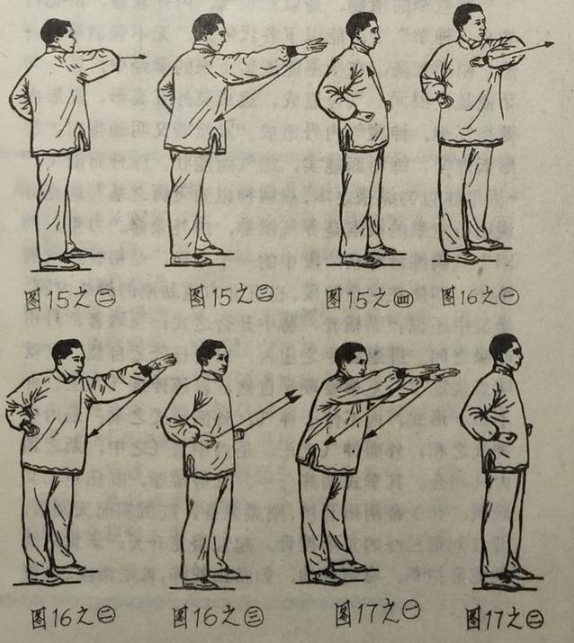
Key Points: Same as the key points for the double insert palm in Figure 4.

